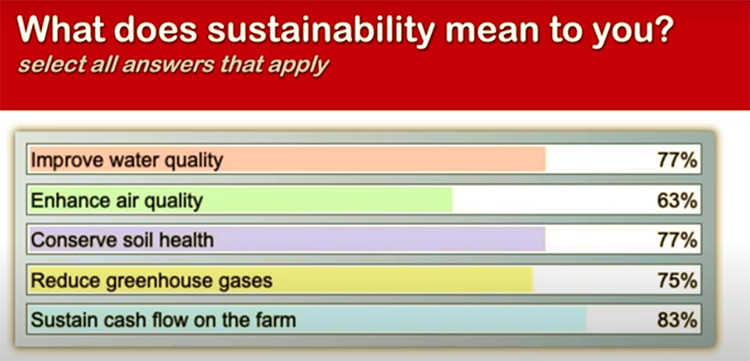
The buzzword of “sustainability” gets mentioned often by mainstream media and the many consumer groups aiming to tackle various societal problems. As Cornell University agricultural economist Chris Wolf put it, “Sustainability is a term that gets pulled out by a lot of different people to mean a lot of different things.”
Many of those people are food processors and consumers, leading farmers to evaluate how they are producing food with the future in mind. So, what exactly should we be evaluating in regard to sustainability? On the July 21 Hoard’s Dairyman DairyLivestream, Virginia Tech’s Robin White reiterated that the dairy industry has already made great gains in many of the major areas that fall under the term.
By the definition of the United Nations, White outlined that sustainability as it pertains to agriculture means “a food system that contributes to food security and nutrition for all people in such a way that the economic, social, cultural, and environmental bases to generate food security and nutrition for all people, now and in future generations, is safeguarded.”
Environment balanced with nutrition
If an average person had to pick one way to describe sustainability, they might likely choose the environmental angle. It is certainly an important one and an area that encompasses everything from water quality and soil health to biodiversity, White listed.
In the current conversations about agricultural sustainability, carbon seems to be the hot topic. Here, dairy certainly has a positive story to share. “The carbon footprint of milk is extremely favorable in comparison to some other products, and particularly when you express that carbon footprint on a nutrient basis,” White said. “In some of our work, we identified that if you eliminated dairy animals from the agricultural system, the net change in the total U.S. greenhouse gas emissions would be something like 0.5% to 1%.”
For that small tradeoff in emissions, though, nutrition — another key factor in the foundation of sustainability — would suffer. White identified that in the U.S. food system, “Dairy products alone produce enough energy to feed 70 million people, enough protein to feed almost 170 million people, and enough calcium to feed the entire U.S. population.”
The economic argument
As with any long-term farm investment, there must be a way for sustainability practices to encourage the farm’s financial sustainability, as well. That was the top consideration when DairyLivestream viewers answered, “What does sustainability mean to you?”

White pointed out that dairy’s advances environmentally and nutritionally have been made because of continual investment in efficiency. “We have really well-documented studies highlighting the links between efficiency and environmental impact, so continuing to work to enhance efficiency is going to improve water footprints, land footprints, and greenhouse gas emissions,” she said.
Socially sustainable
To close, White focused on the social and cultural portions of the U.N.’s definition, noting that this is where our room for opportunity is. As always, sharing the good work and data that dairy production has accomplished is paramount in giving consumers the information they are looking for. “The average food consumer doesn’t know these numbers, and they don’t know how far the dairy industry has come toward the goal of enhancing sustainable food production,” she emphasized.
To watch the recording of the July 21 DairyLivestream, go to the link above. The program recording is now also available as an audio-only podcast on Apple Podcasts, Spotify, Google Podcasts, and downloadable off of the Hoard’s Dairyman website.
An ongoing series of events
The next broadcast of DairyLivestream will be on Wednesday, August 4 at 11 a.m. CDT. Each episode is designed for panelists to answer over 30 minutes of audience questions. If you haven’t joined a DairyLivestream broadcast yet, register here for free. Registering once registers you for all future events.








